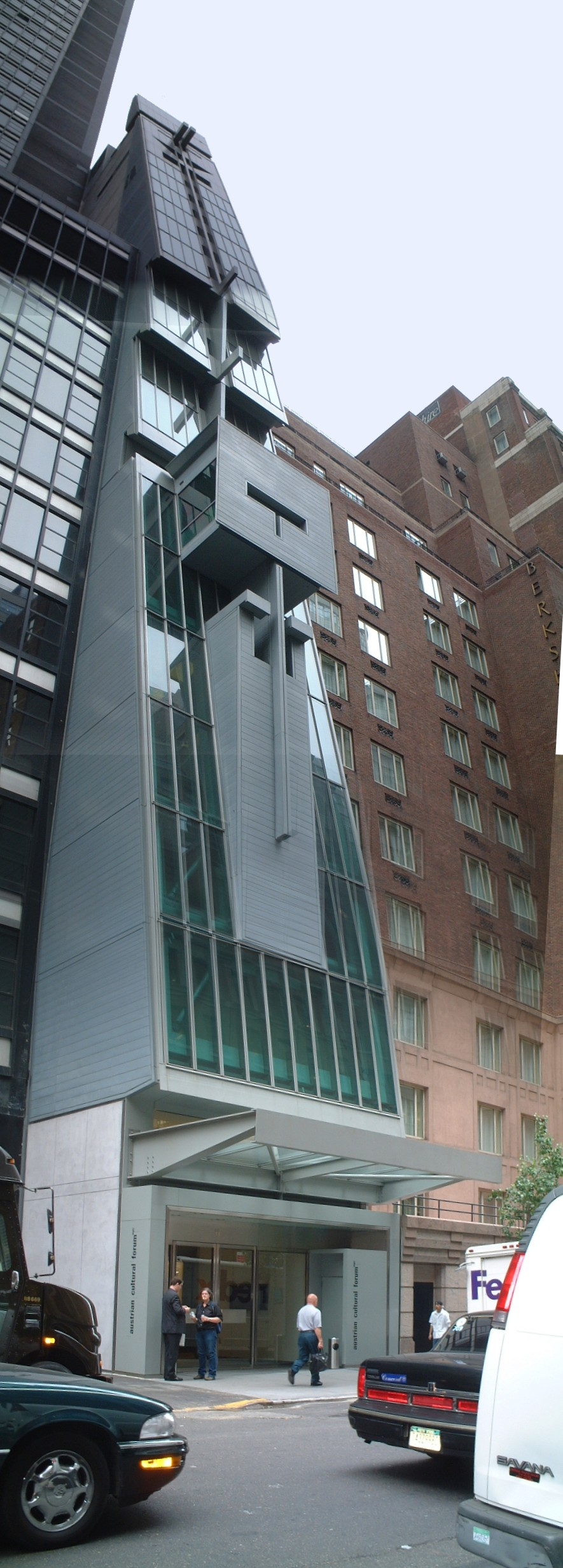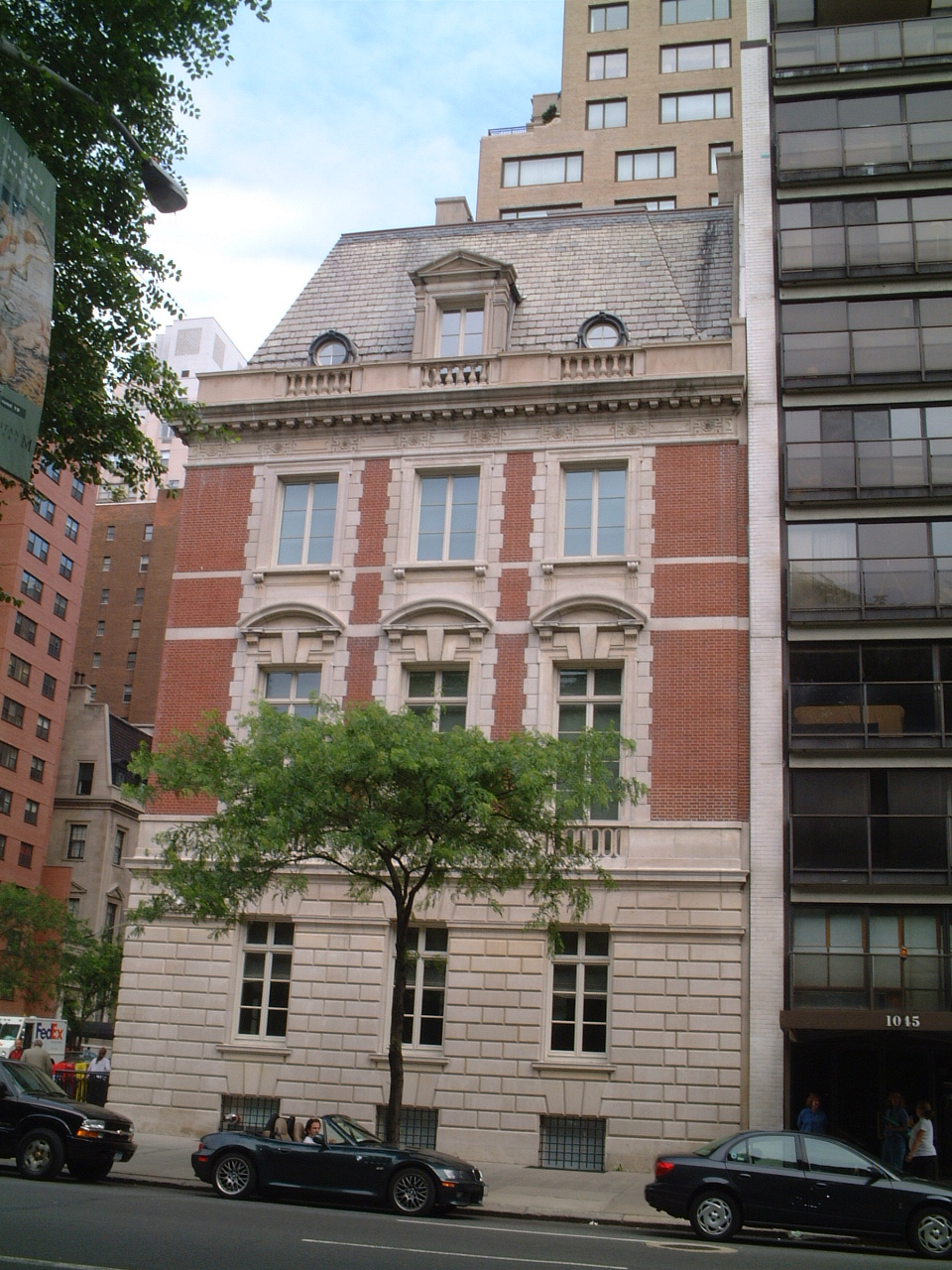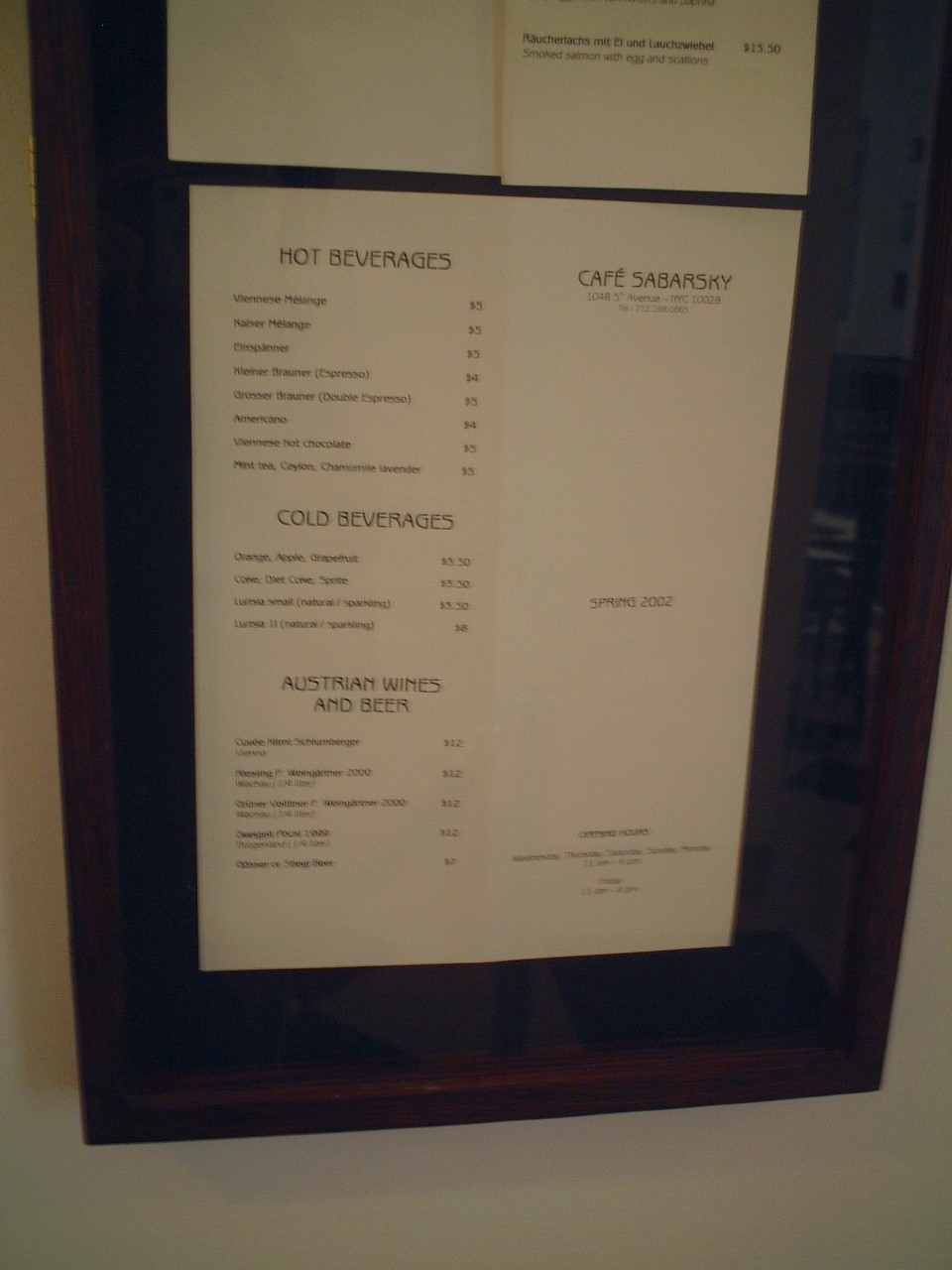Transforming Modernity:
Austrian Culture Goes Global in Neu-York
As the transformations inflicted upon New York’s skyline last fall continue to reverberate through official American public discourse, two Austrian additions to the cultural landscape have opened further uptown to generally appreciative reviews. The Neue Galerie, a museum devoted to early twentieth-century German and Austrian art and design in an elegant mansion on Fifth Avenue and 86th Street that Mrs. Cornelius Vanderbilt once called home, opened in November, 2001, while the doors beneath the graphic blade of the new Austrian Cultural Forum building on East 52nd between Fifth and Madison Avenues were officially opened to the public in April 2002. The appearance, and appearances, of these two structures reveal the tension between two very different visions of Austrian culture, which currently seem to be competing for dominance on the world stage.
 |
 |
| Above: The Neue Galerie as seen from Central
Park Left: The new Austrian Cultural Forum building on East 52 St. |
The ironically named Neue Galerie in fact represents a very traditional view of Austria’s past glories in the realm of art. This view, established by Carl Schorske’s seminal work on Fin-de-Siècle Vienna, looks to the work of Klimt, Kokoschka, Schiele, Loos, et al, and of course father Freud, for insight into the seeming self-destruction of the Habsburg monarchy, and it provides a convenient new canon of great ‘modern’ works, which in turn provides a significant amount of cultural capital to the nation and those identifying with it, who use it to represent themselves internationally (see “Imagining Modern Vienna,” spacesofidentity 1.2). It is therefore to be expected that such an establishment will offer its visitors plenty of opportunities to consume authentic markers supportive of that identity, and sure enough, one discovers in the “General Information” section of the gallery’s pamphlet that it offers:
- the Café Sabarsky: “The museum’s Café, which bears the name of Neue Galerie co-founder Serge Sabarsky, draws its inspiration from the great Viennese cafés that served as important centers of intellectual and artistic life at the turn of the century. Operated by Kurt Gutenbrunner, chef and owner of the renowned restaurant Wallsé, Café Sabarsky serves authentic Viennese specialities. The menu focuses on traditional Austrian dishes, especially fine patisserie, such as strudel and Linzertorte. The Café is outfitted with period objects, including lighting fixtures by Josef Hoffmann, furniture by Adolf Loos, and banquettes that are upholstered with a 1912 Otto Wagner fabric.”
- Book Store: “The Book Store specializes in publications, especially exhibition catalogues, on fine art, architecture, decorative arts, and literature from Germany, Austrian, and related Central European cultures. It also features a selection of posters, postcards, and calendars related to works in the museum’s collection.”
- Design Shop: “The Design Shop offers objects based on original designs by Josef Hoffmann, Adolf Loos, Marianne Brandt, and others. These include jewelry, tableware, textiles, and objets d’art rendered in silver, crystal, porcelain, and other fine materials.”
In other words, what we have here resembles a mini cultural theme park more than it does a museum. A particularly appealing segment of the Austrian past has been seized upon, reproduced in the service of not edification but the accumulation of cultural capital, and offered for sale at a price set to assure that a certain level is maintained. As can be seen from the menu, an authentic Viennese Mélange will set you back $5 (US), while a glass of Zweigelt costs a tidy $12.
 |
In contrast is the new orientation of the restyled Austrian Cultural Forum. In an interview (which can be found on the forum’s website: www.acf.org), its director, Christoph Thun-Hohenstein, explains why the Austrian Ministry for Foreign Affairs decided to change what had previously been its cultural institutes into forums:
All the existing cultural institutions of the Ministry abroad, including the cultural departments of embassies, are included in this concept: an intention to further broaden our platform for more open and fertile discourse as a channel for exchange and understanding. The word forum therefore reflects more accurately the philosophy of the Ministry today. There are 28 of these Austrian cultural outlets in different cities around the world, including two in the United States, in Washington and New York. New York is the largest, of course, the flagship here and internationally. And I think our new building on 52nd Street communicates this boldly.
The provocative parallel Thun-Hohenstein draws here between the fashion industry (outlets, flagship) and cultural ambassadorial work is indicative of the savvy, cosmopolitan image his forum is working hard to foster. This approach to representing Austria looks not to an imagined past, but to a high-flying present; it does not as much reproduce the old as it tries to create the new by supporting contemporary cultural practitioners. The Austrian Cultural Forum’s first season program, “Here is Now” (also available on the forum’s website), is ambitious. An exhibition “Granular Synthesis: WIDE,” a site-specific commissioned work creating an infinite audiovisual space, a meditative kind of irritation by New York-Vienna new media artists Kurt Hentschläger and Ulf Langheinrich, is followed by “Mediations: Archaeologies and Transformations in the Electronic Sphere,” an international symposium on the impact of electronic culture on communication, representation, and creativity. Then, “[f]or one week, electronic music composers from Vienna present their latest works and collaborate in projects with New York-based artists. Under the title ‘The Social Construction of Technology,’ phonoTAKTIK.02 brings together musicians for daytime talks, meet-the-artist activities, parties, sound and video productions that are open to the public.” Also on the plan are “Transforming Modernity: The Arrival of Hyper.Space,” Performing Philosophy, 2 lecture-performances –– the first of The Call with Avital Ronell and the second of In Time with Robin Kelley; “Transforming Literature,” an international, interdisciplinary festival curated by Matthias Konzett of Yale University, presenting modern Austrian literature, art and music in an American context; and “Avant-garde cinema / VISIONary,” a series of screenings, talks, and lectures featuring the likes of Peter Kubelka and Valie Export. The inaugural exhibit on display between May 23 and August 12 –– TransModernity / Austrian Architects –– features “three leading Austrian architectural teams from the generation under 50: henke und schreieck, Jahornegg & Pàlffy, and Riegler Riewe,” and the dramatic sliver of a building housing these events is similarly avant-garde in conception. Architect Raimund Abraham met the challenge of the site’s fiendish limitations (only about 25 feet wide and less than 100 feet deep), with a 24-story structure, the glass-steel façade of which juts down in sections that mimic the falling of a guillotine-blade.
In effect, the Austrian Cultural Forum and the Neue Galerie are yet another incarnation of that old modernist struggle which Peter Bürger so cogently articulated in his 1974 Theory of the Avant-Garde. An historical avant-garde has once again risen up to displace a previously ‘new’ form of modernism that has gotten to be just a little too comfortable, a little too established for comfort. This battle, however, taking place as it does on the international stage, is also a national one. It is noteworthy that it is an Austrian ‘avant-garde’ that is attempting to unseat ‘modern’ Austrian-Americans (the Neue Galerie was a gift to the city of New York from Ronald Lauder, the cosmetics heir and former ambassador to Austria), and that this Austrian avant-garde has chosen to situate its strike in the very heart of American high-brow culture, a few mere blocks from Carnegie Hall. Whether this new avant-garde will prove any more successful than their predecessors –– and how their efforts will resonate as governmental policy ‘back home’ continues to shift –– remains to be seen.
References
Bürger, Peter. Die Theorie des Avant-Garde. Frankfurt: Suhrkamp, 1974.
Schorske, Carl. Fin-De-Siecle Vienna: Politics and Culture. New York: Vintage, 1981.
Wise, Michael Z. “Showing the Flag of Culture (or Not).” April 14, 2002, http://www.nytimes.com.